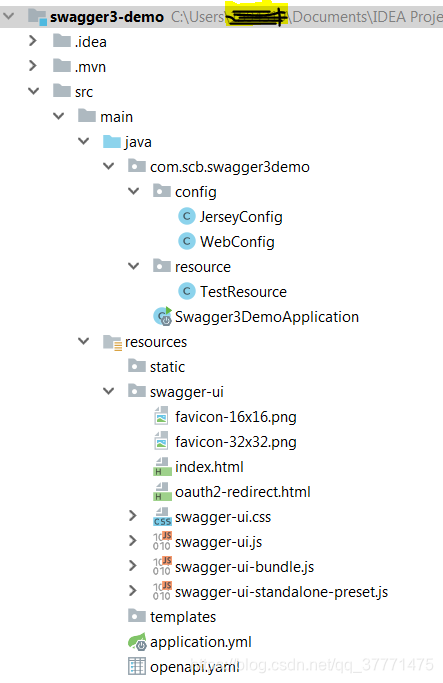OpenApi3规范——Jersey集成swagger-jaxrs2实践
OpenAPI规范(OpenAPI Specification 简称OAS)是Linux基金会的一个项目,试图通过定义一种用来描述API格式或API定义的语言,来规范RESTful服务开发过程。目前V3.0版本的OpenAPI规范(也就是SwaggerV2.0规范)已经发布并开源在github上。即swagger2.0是基于The Apache License, Version 2...
OpenAPI规范(OpenAPI Specification 简称OAS)是Linux基金会的一个项目,试图通过定义一种用来描述API格式或API定义的语言,来规范RESTful服务开发过程。目前V3.0版本的OpenAPI规范(也就是SwaggerV2.0规范)已经发布并开源在github上。即swagger2.0是基于 The Apache License, Version 2.0许可的OAS3.0实现。
一、项目构建
先看下项目结构:

接着,我们直接开始创建项目吧,项目依赖如下:
<?xml version="1.0" encoding="UTF-8"?>
<project xmlns="http://maven.apache.org/POM/4.0.0" xmlns:xsi="http://www.w3.org/2001/XMLSchema-instance"
xsi:schemaLocation="http://maven.apache.org/POM/4.0.0 http://maven.apache.org/xsd/maven-4.0.0.xsd">
<modelVersion>4.0.0</modelVersion>
<parent>
<groupId>org.springframework.boot</groupId>
<artifactId>spring-boot-starter-parent</artifactId>
<version>2.1.6.RELEASE</version>
<relativePath/> <!-- lookup parent from repository -->
</parent>
<groupId>com.scb</groupId>
<artifactId>swagger3-demo</artifactId>
<version>0.0.1-SNAPSHOT</version>
<name>swagger3-demo</name>
<description>Demo project for Spring Boot</description>
<properties>
<java.version>1.8</java.version>
</properties>
<dependencies>
<dependency>
<groupId>org.springframework.boot</groupId>
<artifactId>spring-boot-starter-jersey</artifactId>
</dependency>
<dependency>
<groupId>io.swagger.core.v3</groupId>
<artifactId>swagger-jaxrs2</artifactId>
<version>2.0.0</version>
</dependency>
<dependency>
<groupId>org.springframework.boot</groupId>
<artifactId>spring-boot-starter-web</artifactId>
</dependency>
<dependency>
<groupId>org.springframework.boot</groupId>
<artifactId>spring-boot-starter-test</artifactId>
<scope>test</scope>
</dependency>
</dependencies>
<build>
<plugins>
<plugin>
<groupId>org.springframework.boot</groupId>
<artifactId>spring-boot-maven-plugin</artifactId>
</plugin>
</plugins>
</build>
</project>
二、配置
1、在application.yml中做如下配置,将Jersey的根路径配置为/rest。也可以使用@ApplicationPath("/rest")配置。
spring:
jersey:
application-path: rest2、JerseyConfig
package com.scb.swagger3demo.config;
import com.scb.swagger3demo.resource.TestResource;
import io.swagger.v3.jaxrs2.integration.resources.AcceptHeaderOpenApiResource;
import io.swagger.v3.jaxrs2.integration.resources.OpenApiResource;
import org.glassfish.jersey.server.ResourceConfig;
import org.springframework.beans.factory.annotation.Value;
import org.springframework.stereotype.Component;
@Component
public class JerseyConfig extends ResourceConfig {
@Value("${spring.jersey.application-path}")
private String apiPath;
public JerseyConfig() {
// open api
register(OpenApiResource.class);
register(AcceptHeaderOpenApiResource.class);
// resource
register(TestResource.class);
}
}这里需要注册两个类,OpenApiResource和AcceptHeaderOpenApiResource,用于集成Swagger。然后注册一个TestResource,作为资源对象。
3、TestResource资源类
package com.scb.swagger3demo.resource;
import io.swagger.v3.oas.annotations.Operation;
import io.swagger.v3.oas.annotations.Parameter;
import io.swagger.v3.oas.annotations.media.Content;
import io.swagger.v3.oas.annotations.media.Schema;
import io.swagger.v3.oas.annotations.responses.ApiResponse;
import org.springframework.stereotype.Component;
import javax.ws.rs.*;
import javax.ws.rs.core.MediaType;
@Component
@Path("/test")
public class TestResource {
@GET
@Path("/{name}")
@Produces(MediaType.APPLICATION_JSON)
@Consumes(MediaType.APPLICATION_JSON)
@Operation(summary = "OpenApi 3 test",
tags = {"TestResource"},
responses = {
@ApiResponse(description = "return Hello world",content = @Content(schema = @Schema(implementation = String.class)))
})
public String findByName(@Parameter(description = "name",required = true) @PathParam(value = "name") String name) {
return "Hello world.Hey "+name;
}
}
到这里,一个简单的Jersey集成Swagger已经搭建完成。运行项目,访问http://localhost:8080/rest/openapi.json即可得到Api文档。
然后,我们接着看如何集成swagger-ui。
三、Swagger-ui集成
1、swagger-ui下载
从swagger-ui官网:https://github.com/swagger-api/swagger-ui下载zip包。然后解压缩,将dist目录下的文件按照开头项目结构所示复制进去。
注意:需要修改swagger-ui的index.html,在index.html中找到url,将其改为
url: "/rest/openapi.json",这是项目openapi.json的路径。
2、配置访问swagger-ui路径
package com.scb.swagger3demo.config;
import org.springframework.context.annotation.Configuration;
import org.springframework.web.servlet.config.annotation.EnableWebMvc;
import org.springframework.web.servlet.config.annotation.ResourceHandlerRegistry;
import org.springframework.web.servlet.config.annotation.WebMvcConfigurer;
@Configuration
@EnableWebMvc
public class WebConfig implements WebMvcConfigurer {
@Override
public void addResourceHandlers(ResourceHandlerRegistry registry) {
registry.addResourceHandler("/swagger-ui/**").addResourceLocations("classpath:/swagger-ui/");
}
}3、新建openapi.yaml
resourcePackages:
- com.scb.swagger3demo
prettyPrint: true
cacheTTL: 0
openAPI:
info:
version: '0.0.1-SNAPSHOT'
title: swagger3-demo
description: 'swagger3 demo api document'
termsOfService: http://swagger.io/terms/
license:
name: Apache 2.0
url: http://www.apache.org/licenses/LICENSE-2.0.html
There are several ways to provide configuration; probably the easiest and least intrusive way is adding a yaml (or json) file named
openapi.yamloropenapi-configuration.yamlto the classpath of your application。
上面是官网推荐方式来配置Swagger,也是最简单侵入最少的方式。如果你喜欢Java Config的话,也可以使用JAX-RS Application来配置:
package com.scb.swagger3demo.config;
import io.swagger.v3.jaxrs2.integration.JaxrsOpenApiContextBuilder;
import io.swagger.v3.oas.integration.OpenApiConfigurationException;
import io.swagger.v3.oas.integration.SwaggerConfiguration;
import io.swagger.v3.oas.models.OpenAPI;
import io.swagger.v3.oas.models.info.Contact;
import io.swagger.v3.oas.models.info.Info;
import io.swagger.v3.oas.models.info.License;
import org.springframework.stereotype.Component;
import javax.servlet.ServletConfig;
import javax.ws.rs.ApplicationPath;
import javax.ws.rs.core.Application;
import javax.ws.rs.core.Context;
import java.util.stream.Collectors;
import java.util.stream.Stream;
@Component
@ApplicationPath("/rest")
public class SwaggerConfig extends Application {
public SwaggerConfig(@Context ServletConfig servletConfig) {
super();
OpenAPI oas = new OpenAPI();
Info info = new Info()
.title("Swagger Sample App bootstrap code")
.description("This is a sample server Petstore server. You can find out more about Swagger " +
"at [http://swagger.io](http://swagger.io) or on [irc.freenode.net, #swagger](http://swagger.io/irc/). For this sample, " +
"you can use the api key `special-key` to test the authorization filters.")
.termsOfService("http://swagger.io/terms/")
.contact(new Contact()
.email("apiteam@swagger.io"))
.license(new License()
.name("Apache 2.0")
.url("http://www.apache.org/licenses/LICENSE-2.0.html"));
oas.info(info);
SwaggerConfiguration oasConfig = new SwaggerConfiguration()
.openAPI(oas)
.prettyPrint(true)
.resourcePackages(Stream.of("com.scb.swagger3demo").collect(Collectors.toSet()));
try {
new JaxrsOpenApiContextBuilder()
.servletConfig(servletConfig)
.application(this)
.openApiConfiguration(oasConfig)
.buildContext(true);
} catch (OpenApiConfigurationException e) {
throw new RuntimeException(e.getMessage(), e);
}
}
}
更多配置方式请参考:Swagger-2.X Configuration
四、运行结果
至此,一个完整的Jersey集成swagger已经开发完成。运行项目,访问http://localhost:8080/swagger-ui/index.html,即可得到如下界面:

更多推荐
 已为社区贡献2条内容
已为社区贡献2条内容










所有评论(0)